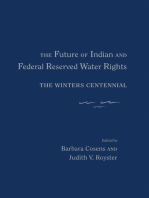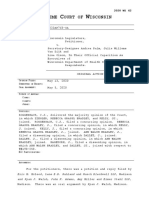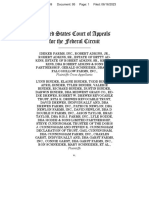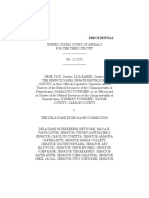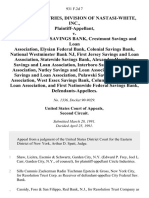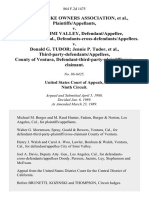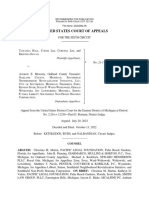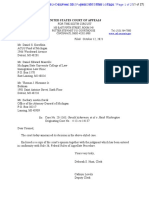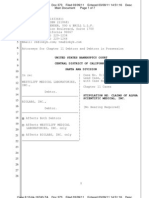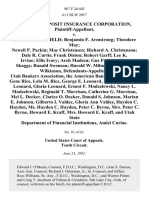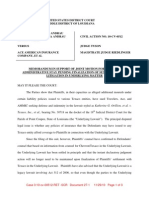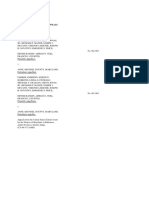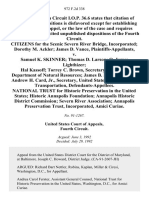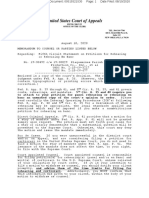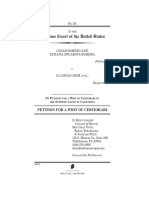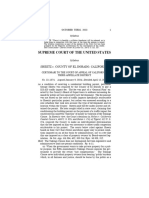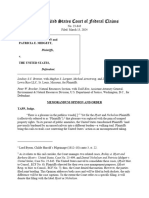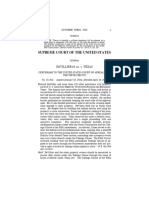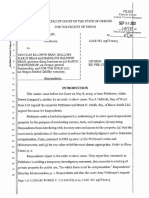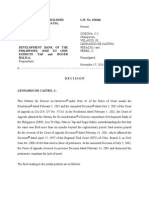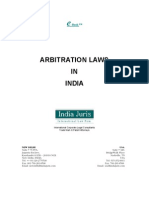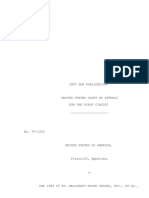Professional Documents
Culture Documents
Milton v. United States, No. 21-1131 (Fed. Cir. June 2, 2022)
Uploaded by
RHTOriginal Description:
Original Title
Copyright
Available Formats
Share this document
Did you find this document useful?
Is this content inappropriate?
Report this DocumentCopyright:
Available Formats
Milton v. United States, No. 21-1131 (Fed. Cir. June 2, 2022)
Uploaded by
RHTCopyright:
Available Formats
Case: 21-1131 Document: 120 Page: 1 Filed: 06/02/2022
United States Court of Appeals
for the Federal Circuit
______________________
VIRGINIA MILTON AND ARNOLD MILTON, ON
BEHALF OF THEMSELVES AND ALL OTHER
SIMILARLY SITUATED PERSONS, ET AL.,
Plaintiffs-Appellants
TRAVELERS EXCESS AND SURPLUS LINES
COMPANY,
Plaintiff-Appellant
v.
UNITED STATES,
Defendant-Appellee
______________________
2021-1131, 2021-1132, 2021-1133, 2021-1134, 2021-1135,
2021-1136, 2021-1137, 2021-1138, 2021-1139, 2021-1140,
2021-1142, 2021-1143, 2021-1144, 2021-1145, 2021-1146,
2021-1147, 2021-1148, 2021-1151, 2021-1152, 2021-1155,
2021-1157, 2021-1159, 2021-1161, 2021-1162, 2021-1163,
2021-1164, 2021-1165, 2021-1167, 2021-1171, 2021-1172,
2021-1173, 2021-1174, 2021-1175, 2021-1176, 2021-1177,
2021-1178, 2021-1184, 2021-1186, 2021-1187, 2021-1188,
2021-1189, 2021-1190, 2021-1192, 2021-1193, 2021-1195,
2021-1196, 2021-1197, 2021-1198, 2021-1199, 2021-1200,
2021-1201, 2021-1204, 2021-1205, 2021-1206, 2021-1207,
2021-1208, 2021-1214, 2021-1215, 2021-1216, 2021-1217,
2021-1218, 2021-1220, 2021-1221, 2021-1222, 2021-1223,
2021-1224, 2021-1225, 2021-1230, 2021-1231, 2021-1232,
2021-1233, 2021-1234, 2021-1237, 2021-1238, 2021-1239,
2021-1240, 2021-1241, 2021-1242, 2021-1243, 2021-1244,
2021-1250, 2021-1251, 2021-1252, 2021-1253, 2021-1254,
Case: 21-1131 Document: 120 Page: 2 Filed: 06/02/2022
2 MILTON v. US
2021-1255, 2021-1256, 2021-1268, 2021-1269, 2021-1270,
2021-1271, 2021-1272, 2021-1273, 2021-1274, 2021-1275,
2021-1276, 2021-1277, 2021-1279, 2021-1280, 2021-1281,
2021-1282, 2021-1283, 2021-1284, 2021-1285, 2021-1286,
2021-1287, 2021-1288, 2021-1289, 2021-1290, 2021-1291,
2021-1293, 2021-1294, 2021-1295, 2021-1296, 2021-1302,
2021-1303, 2021-1304, 2021-1305, 2021-1306, 2021-1307,
2021-1308, 2021-1309, 2021-1310, 2021-1311, 2021-1312,
2021-1313, 2021-1314, 2021-1315, 2021-1316, 2021-1317,
2021-1318, 2021-1319, 2021-1320, 2021-1322, 2021-1324,
2021-1325, 2021-1335, 2021-1336, 2021-1337, 2021-1338,
2021-1339, 2021-1341, 2021-1394, 2021-1398, 2021-1403,
2021-1404, 2021-1405, 2021-1406, 2021-1407, 2021-1427,
2021-1429, 2021-1431, 2021-1444, 2021-1455, 2021-1464,
2021-1465, 2021-1467, 2021-1468, 2021-1472, 2021-1479,
2021-1481, 2021-1482, 2021-1483, 2021-1492, 2021-1494,
2021-1499, 2021-1513, 2021-1529, 2021-1539, 2021-1540,
2021-1541, 2021-1847, 2021-1889, 2021-1890, 2021-1891,
2021-1894, 2021-1947, 2021-2047
______________________
Appeals from the United States Court of Federal
Claims in Nos. 1:17-cv-01235-LAS, 1:17-cv-09002-LAS,
Senior Judge Loren A. Smith.
______________________
Decided: June 2, 2022
______________________
RUSSELL STANLEY POST, Beck Redden LLP, Houston,
TX, argued for all plaintiffs-appellants. Plaintiffs-appel-
lants Virginia Milton, Arnold Milton, Edward J. Bush,
Christopher Tita, Ijang Fomukong-Tita, Caleb S. Atwood,
Juan Atwood, Sook N. Byun, Suck D. Cho, Erin R. Dan-
ielson, Stephen E. Danielson, John DeFilippo, Marylyn L.
DeFilippo, Energy Building Systems, Inc., Jorge E.
Galindo, Ashish Gupta, Shibani Gupta, L. Katherine
Haute, Mary C. Horany, Monzer Hourani, Kaslik
Case: 21-1131 Document: 120 Page: 3 Filed: 06/02/2022
MILTON v. US 3
Investments, L.C., Gerrit O. Kirkwood, Chil S. Ko, Joanna
Krakowiak, Hyunil Jo Lee, Shina Lee, Charles J. Lucas Jr.,
Jamie Manning, Rad Manning, Tommy T. Maoz, Yong H.
Marx, Ina N. O'Connor, Frank Papapanagiotou, Karen N.
Pillai, Rajeev R. Pillai, Cherie D. Platt, John D. Platt, Lau-
ren A. Platt, Prashanthi M. Prasad, Amer A. Rahim, Deb-
orah D. Regone, William R. Regone, Sophia Riemann, Matt
Sharrock, Traci Sharrock, Sachin Sheldekar, Gerald
Siegmyer, Marian Siegmyer, Julie D. Sparks, Michael W.
Sparks, John Hughes Tenison, Catherine C. Yen, Jerome
C. Yen, Debora H. York, William H. York, David Young,
Tami Young, Nan Zhang, Xuechen Zhang, Weili Zhu, Sejla
Bakalovic, Briarhills Office, Ltd., Beverly Bugler, Richard
Bugler, Allen Caine, Fernando Carvalho, Thomas Dams-
gaard, Helena De Ferro, Jean Ann Dieudonne, John Sutter
Dieudonne, Blanca Franklin, Bruce Franklin, Rosa Frimm,
Michael Lawson, Penelope P. Lawson, Heather Papado-
poulos, John Papadopoulos, Risa Pippin, Dawn Rasch, Ste-
ven Rasch, Bamir Rudic, Gabrielle Strout, Marceline
Sutter, Jennifer Teixeira, Maurice Teixeira, Nancy N.
Tucker, Thomas E. Tucker, Charlie Whitson, Linda Whit-
son, Steve Wortham, Shoelen Derrington, Carlos Escobar,
Susan P. O'Keefe, Genie Panaccione, Robert Panaccione,
Byron N. Plant, Lysette M. Plant, Keith Ron, T. Scott, Ei-
leen D. Zwart, Peter Zwart, Donald R. Ray, Judy Ray, Billie
Williams, Liliana Williams also represented by PARTH
GEJJI, DAVID M. GUNN.
RAND PATRICK NOLEN, Fleming, Nolen & Jez, L.L.P.,
Houston, TX, for plaintiffs-appellants Virginia Milton, Ar-
nold Milton, Edward J. Bush, Christopher Tita, Ijang
Fomukong-Tita.
JOSEPH CARL CECERE, JR., Cecere PC, Dallas, TX, for
plaintiffs-appellants Martha Pollack, AGL, LLC, Jonathan
Levy. Also represented by JASON ARON ITKIN, NOAH
MICHAEL WEXLER, Arnold & Itkin, LLP, Houston, TX.
Case: 21-1131 Document: 120 Page: 4 Filed: 06/02/2022
4 MILTON v. US
JEFFREY RANKIN LEARNED, Denenberg Tuffley, PLLC,
Southfield, MI, for plaintiffs-appellants American Home
Assurance Company, Great Lakes Insurance SE, Lexing-
ton Insurance Company.
BRYANT STEVEN BANES, Neel, Hooper & Banes, P.C.,
Houston, TX, for plaintiffs-appellants Randy D. Horsak,
Mervin Chess, Randall Teufel. Also represented by SARAH
P. HARRIS.
BENJAMIN LEWIS, Carroll Warren & Parker, Jackson,
MS, for plaintiff-appellant Travelers Excess and Surplus
Lines Company. Also represented by MONIKA F. MOORE,
Houston, TX.
BRIAN C. TOTH, Environment and Natural Resources
Division, United States Department of Justice, Washing-
ton, DC, argued for defendant-appellee. Also represented
by JEAN E. WILLIAMS.
NANCIE GAIL MARZULLA, Marzulla Law, LLC, Washing-
ton, DC, for amici curiae Hulak Abed-Stephen, Zavik Abed-
Stephen, Joan C. Alford. Also represented by ROGER J.
MARZULLA; FRED HAGANS, Hagans Montgomery Hagans,
Houston, TX.
______________________
Before LOURIE, CHEN, and CUNNINGHAM, Circuit Judges.
CUNNINGHAM, Circuit Judge.
Appellants Virginia Milton and hundreds of other indi-
viduals and companies owned property downstream from
the Addicks and Barker Dams in Houston, Texas. They
allege that the Army Corps of Engineers flooded their prop-
erties when it opened the dams’ floodgates during Hurri-
cane Harvey. Now, they appeal from the decision of the
United States Court of Federal Claims holding that they do
not have a cognizable property interest in perfect flood
Case: 21-1131 Document: 120 Page: 5 Filed: 06/02/2022
MILTON v. US 5
control, and thus they cannot state takings claims against
the United States. See In re Downstream Addicks &
Barker (Tex.) Flood-Control Reservoirs, 147 Fed. Cl. 566
(2020). We hold that Appellants have alleged cognizable
property interests in flowage easements, reverse the deci-
sion of the Court of Federal Claims, and remand for further
proceedings consistent with this opinion.
I. BACKGROUND
A. Factual Background
At the western edge of Houston there is a watershed
called Buffalo Bayou. J.A. 992. Despite its picturesque
name, Buffalo Bayou was the site of “devastating floods in
1929 and 1935.” J.A. 995. In the floods’ aftermath, Con-
gress authorized construction of dams on the bayou and its
tributaries. Pub. L. No. 75-685, 52 Stat. 802, 804 (1938).
The result was Barker Dam (completed in 1945) and Ad-
dicks Dam (completed in 1948). J.A. 995–97. By 1963,
each dam held behind it a large reservoir and had five
gated outflowing conduits. J.A. 995–96.
In line with its responsibility for flood control, the
Corps adopted the Addicks and Barker Reservoirs Water
Control Manual published in 2012. See J.A. 974–1131. The
Manual provides that if an inch of rain falls within a 24-
hour period or if downstream flooding is expected, the
Corps must close the dams’ floodgates. J.A. 1022. If the
water in the reservoirs reaches set heights—101 feet be-
hind Addicks Dam or 95.7 feet behind Barker Dam—a sur-
charge regulation kicks in. J.A. 1023. At this point, the
Corps must monitor whether the inflow will continue to
cause the reservoirs to rise. Id. “If inflow and pool eleva-
tion conditions dictate,” the Corps releases water from the
reservoir according to a set schedule. Id. At the beginning
of 2017, such induced surcharges had never been made.
J.A. 1416.
Case: 21-1131 Document: 120 Page: 6 Filed: 06/02/2022
6 MILTON v. US
Then, Hurricane Harvey approached Houston. The
reservoirs were empty before the storm made landfall. J.A.
4661, 5194. On August 25, 2017, the Corps closed the
dams’ floodgates. J.A. 5202. Shortly after, Hurricane Har-
vey made landfall. J.A. 936. Although Hurricane Harvey
soon weakened into a tropical storm, it still poured more
than thirty inches of water onto the city in four days. Id.
In the early hours of August 28, the conditions for the in-
duced surcharge regulations were met. J.A. 4657. The
Corps proceeded to release up to 8,000 cubic feet per second
of water from behind the dams. J.A. 5208–09. The follow-
ing day, it increased the release from up to 8,000 to 12,000
cubic feet per second. J.A. 5209–11. On August 30, it again
increased the release from 12,000 to 13,000 cubic feet per
second, a rate the Corps maintained until September 4.
J.A. 5211–13.
Substantial downstream flooding followed. The Gov-
ernment’s expert believes that some of Appellants’ proper-
ties were flooded for more than eleven days and some were
flooded at a maximum depth greater than eight feet above
the first finished floor. J.A. 2315. Several Appellants tes-
tified that they evacuated their homes by boat. J.A.
1674–94, 4195, 4270. Appellants assert that many of their
properties incurred hundreds of thousands, if not millions,
of dollars in damage each. See J.A. 1721–1861, 4195.
B. Procedural History
Following this tragedy, hundreds of property owners
filed complaints in the Court of Federal Claims alleging
that the flooding constituted an uncompensated, physical
taking of their property by the Government. In re Down-
stream, 147 Fed. Cl. at 570, 574. The Court of Federal
Claims joined all these cases into a Master Docket and then
split them into an Upstream Sub-Docket—for properties
upstream of the dams—and a Downstream Sub-Docket—
for properties downstream of the dams. Id.
Case: 21-1131 Document: 120 Page: 7 Filed: 06/02/2022
MILTON v. US 7
In the Upstream Sub-Docket, the court found that
plaintiffs were owners of land not subject to flowage ease-
ments, meaning that they had valid property interests that
could be taken. In re Upstream Addicks & Barker (Tex.)
Flood-Control Reservoirs, 146 Fed. Cl. 219, 248–49 (2019).
After a trial, the court found that the Government flooded
plaintiffs’ properties and so engaged in a taking. Id. at 264.
The Downstream Sub-Docket proceeded differently.
There, the court ultimately granted the Government’s mo-
tions to dismiss and for summary judgment and denied Ap-
pellants’ motion for summary judgment. In re
Downstream, 147 Fed. Cl. at 584. Specifically, the court
held that Appellants did not articulate a cognizable prop-
erty interest that the Government could take because “nei-
ther Texas law nor federal law creates a protected property
interest in perfect flood control in the face of an Act of God.”
Id. at 570. Under Texas law, the court wrote, Appellants
“own their land subject to the legitimate exercise of the po-
lice power to control and mitigate against flooding.” Id. at
578. The court held that “Texas law has specifically limited
liability in both a takings and a tort context where the op-
erator of a water control structure fails to perfectly miti-
gate against flooding caused by an Act of God.” Id. at 579.
Finally, the court concluded that as “each of the plaintiffs
in this case acquired their property after the construction
of the Addicks and Barker Dams and Reservoirs, plaintiffs
acquired their properties subject to the superior right of the
Corps to engage in flood mitigation and to operate accord-
ing to its Manual.” Id. at 580 (emphasis in original).
The court also did not find a cognizable property inter-
est under federal law. Looking to the Flood Control Act of
1928, 33 U.S.C. § 702c, the court held that “simply owning
property that benefits from flood control structures does
not by itself confer upon those owners a vested right in per-
fect flood control.” Id. at 582. The court further wrote that
the Supreme Court has “routinely” held that “the govern-
ment cannot be held liable under the Fifth Amendment for
Case: 21-1131 Document: 120 Page: 8 Filed: 06/02/2022
8 MILTON v. US
property damages caused by events outside of the govern-
ment’s control.” Id. at 583 (collecting cases). Thus, the
court concluded that because there was no cognizable prop-
erty interest under either state or federal law, Appellants
had failed to state a claim upon which relief could be
granted. Id. at 583–84.
These appeals followed. We have jurisdiction pursuant
to 28 U.S.C. § 1295(a)(3).
II. DISCUSSION
A. Legal Framework
The Fifth Amendment forbids the government from
taking private property “for public use, without just com-
pensation.” U.S. Const. amend. V. Courts must evaluate
two prongs in determining whether a government action
constitutes a taking. “First, the court determines whether
the claimant has identified a cognizable Fifth Amendment
property interest that is asserted to be the subject of the
taking. Second, if the court concludes that a cognizable
property interest exists, it determines whether that prop-
erty interest was ‘taken.’” Acceptance Ins. Cos., Inc. v.
United States, 583 F.3d 849, 854 (Fed. Cir. 2009) (citation
omitted).
“We review the Court of Federal Claims’ legal conclu-
sions de novo.” Hardy v. United States, 965 F.3d 1338,
1344 (Fed. Cir. 2020) (citing Holland v. United States, 621
F.3d 1366, 1374 (Fed. Cir. 2010)). Whether a compensable
property interest exists is a question of law. Id. (citing Ca-
sitas Mun. Water Dist. v. United States, 708 F.3d 1340,
1351 (Fed. Cir. 2013)). “Whether a taking under the Fifth
Amendment has occurred is a question of law with factual
underpinnings.” Id. (quoting Cary v. United States, 552
F.3d 1373, 1376 (Fed. Cir. 2009)).
Case: 21-1131 Document: 120 Page: 9 Filed: 06/02/2022
MILTON v. US 9
B. The Flood Control Act
Before turning to whether a cognizable property inter-
est exists, we first address the Government’s argument
that it is immune from suits alleging takings based on its
flood control measures. The Government contends that
Congress enacted the Flood Control Act of 1928, 33 U.S.C.
§ 702c, “to ensure beyond doubt that sovereign immunity
would protect the Government from ‘any’ liability associ-
ated with flood control.” Appellee’s Br. 25 (quoting United
States v. James, 478 U.S. 597, 608 (1986)). In other words,
the Government argues that the United States is immune
from takings claims that stem from Government attempts
at flood control.
The Government cannot avoid suit so easily. Under the
Tucker Act, which predates the Flood Control Act by more
than 40 years, the United States granted the Court of Fed-
eral Claims jurisdiction over—and waived sovereign im-
munity from—“any claim against the United States
founded either upon the Constitution, or . . . for liquidated
or unliquidated damages in cases not sounding in tort.” 28
U.S.C. § 1491(a)(1). In California v. United States, we held
that there was no evidence in the text or legislative history
of the Flood Control Act “that Congress had ‘withdrawn the
Tucker Act grant of jurisdiction.’” 271 F.3d 1377, 1383
(Fed. Cir. 2001) (quoting Ruckelshaus v. Monsanto Co., 467
U.S. 986, 1017 (1984)). Section 702c, thus, does not pre-
clude Court of Federal Claims jurisdiction over this case.
C. Existence of a Cognizable Property Interest
Having concluded that the Government is not immune
from Appellants’ takings claims, we turn to whether the
Court of Federal Claims correctly determined that Appel-
lants did not establish a cognizable property interest. We
hold that the Court of Federal Claims erred, and such a
cognizable property interest exists.
Case: 21-1131 Document: 120 Page: 10 Filed: 06/02/2022
10 MILTON v. US
We are tasked with examining whether Appellants
have “identified” a cognizable property interest. Ac-
ceptance, 583 F.3d at 854. Appellants’ master complaint
alleges that the Government took flowage easements in the
flooded properties. J.A. 121 (¶ 117). We, therefore, con-
sider whether Appellants have a cognizable property inter-
est in flowage easements.
“It is well settled that existing rules and understand-
ings and background principles derived from an independ-
ent source, such as state, federal, or common law, define
the dimensions of the requisite property rights for purposes
of establishing a cognizable taking.” Acceptance, 583 F.3d
at 857 (internal quotation omitted). Texas courts have rec-
ognized that property owners have interests in flowage
easements under Texas law. See, e.g., Harris Cnty. Flood
Control Dist. v. Kerr, 499 S.W.3d 793, 802 (Tex. 2016); Tar-
rant Reg’l Water Dist. v. Gragg, 151 S.W.3d 546, 550 (Tex.
2004); Gleghorn v. City of Wichita Falls, 545 S.W.2d 446,
447 (Tex. 1976). And so, under Texas law, a right to grant
a flowage easement “is one of the rights in the bundle of
sticks of property rights that inheres in a res.” Acceptance,
583 F.3d at 857 (quoting Am. Pelagic Fishing Co., L.P. v.
United States, 379 F.3d 1363, 1376 (Fed. Cir. 2004)). The
Government argues that several exceptions negate Appel-
lants’ property interests. We disagree.
First, the Government contends that Appellants do not
have a cognizable property interest because “Texas law rec-
ognizes that ‘all property is held subject to the valid exer-
cise of the police power’ by the government to provide for
public health and safety.” Appellee’s Br. 19 (quoting City
of Dallas v. Stewart, 361 S.W.3d 562, 569 (Tex. 2012)). The
Government asserts that flood control is such an exercise
of the police power. Id. at 19–20. But the Government
stretches the holdings of the cases it cites to reach that con-
clusion. In Stewart and two other cases that the Govern-
ment cites—Severance v. Patterson, 370 S.W.3d 705 (Tex.
2012), and Lombardo v. City of Dallas, 73 S.W.2d 475 (Tex.
Case: 21-1131 Document: 120 Page: 11 Filed: 06/02/2022
MILTON v. US 11
1934)—the Texas Supreme Court expressly tied the exer-
cise of the police power to the abatement of nuisances. See
Severance, 370 S.W.3d at 710; Stewart, 361 S.W.3d at 569;
Lombardo, 73 S.W.2d at 479. Here, there is no allegation
that Appellants’ properties constituted public nuisances.
And the case that the Government cites to connect the con-
trol of flood waters to the police power—Motl v. Boyd, 286
S.W. 458 (Tex. 1926)—is about the scope of riparian rights,
not flowage easements or even takings. Id. at 463; see
Brazos River Auth. v. City of Graham, 354 S.W.2d 99, 105
(Tex. 1961) (similarly distinguishing Motl). A general po-
lice power exception to property rights does not exist under
Texas law. Stewart, 361 S.W.3d at 575 (noting that Texas
law has “moved beyond the earlier notion that the govern-
ment’s duty to pay for taking property rights is excused by
labeling the taking as an exercise of the police powers”
(quoting Steele v. City of Hous., 603 S.W.2d 786, 789
(1980))).
The Government cites other cases that it argues “re-
jected claims for takings from the controlled release of wa-
ter from reservoirs in response to unprecedented rainfall,”
consistent with the Government’s understanding of the
scope of the police power. Appellee’s Br. 20. But these
cases are also distinguishable. Waller v. Sabine River Au-
thority, Case No. 09-18-00040-CV, 2018 WL 6378510, at *5
(Tex. App. Dec. 6, 2018), Sabine River Authority v. Hughes,
92 S.W.3d 640, 642 (Tex. App. 2002), and Wickham v. San
Jacinto River Authority, 979 S.W.2d 876, 883–84 (Tex. App.
1998), each concluded that plaintiffs had failed to present
sufficient evidence that water released from the relevant
dam flooded their property. Thus, in no case did the rele-
vant river authority engage in a “taking” under the Texas
constitution. Waller, 2018 WL 6378510, at *4–5; Sabine,
92 S.W.3d at 641–42; Wickham, 979 S.W.2d at 880, 884.
None of these decisions turned on whether the plaintiffs
had a cognizable property interest.
Case: 21-1131 Document: 120 Page: 12 Filed: 06/02/2022
12 MILTON v. US
Similarly, the Government incorrectly asserts that Ap-
pellants do not have a cognizable property interest because
Hurricane Harvey was an Act of God. See Appellee’s Br.
20–21. Rather, Acts of God relate, if at all, to whether a
taking has occurred, not whether a party has a cognizable
property interest. For example, in Kerr, the Texas Su-
preme Court gave six reasons for concluding that a taking
had not occurred under the Texas constitution, one of
which was that the flooding resulted from Acts of God. 499
S.W.3d at 799, 807. Other cases that the Government cites
similarly do not stand for the broad proposition that prop-
erty is held subject to Acts of God. See Luther Transfer &
Storage, Inc. v. Walton, 296 S.W.2d 750, 753 (Tex. 1956)
(discussing an Act of God as part of proximate causation
analysis in negligence lawsuit); McWilliams v. Masterson,
112 S.W.3d 314, 320–21 (Tex. App. 2003) (same); Benavides
v. Gonzalez, 396 S.W.2d 512, 514 (Tex. App. 1965) (address-
ing defense to Texas statute prohibiting “any person to di-
vert the natural flow of surface waters in this State or to
impound such waters in such manner as to damage the
property of another by overflow of such waters so diverted
or impounded”).
The Government next contends that Appellants’ prop-
erty rights “are limited by the owners’ expectations as of
the date they acquired their properties.” Appellee’s Br. 22.
Again, we disagree. 1 One case that the Government relies
on turns on the level of intent needed to state a takings
claim under the Texas Constitution. City of Tyler v. Likes,
962 S.W.2d 489, 504–05 (Tex. 1997). Likes does not suggest
a broad limit on property rights. Id. at 504–05 (not discuss-
ing scope of property rights when addressing plaintiff’s tak-
ings claim). And the Government’s other case—City of
1 We note that plaintiffs allege a physical, rather
than a regulatory, taking. In re Downstream, 147 Fed. Cl.
at 570.
Case: 21-1131 Document: 120 Page: 13 Filed: 06/02/2022
MILTON v. US 13
Dallas v. Winans, 262 S.W.2d 256, 259 (Tex. Civ. App.
1953)—is not about takings; instead, Winans discusses to
whom a nuisance cause of action accrues. There is no blan-
ket rule under Texas law that property rights are held sub-
ject to owners’ expectations on acquisition.
Finally, we turn to the Government’s argument that
Appellant’s property rights are held subject to the police
power under federal law. See Appellee’s Br. 28–32. The
Supreme Court has rejected the notion that private prop-
erty is subject to “unbridled, uncompensated qualification
under the police power.” Lucas v. S.C. Coastal Council, 505
U.S. 1003, 1014 (1992). But the Supreme Court has recog-
nized that a taking may be non-compensable if there is “the
destruction of ‘real and personal property, in cases of actual
necessity, to prevent the spreading of a fire’ or to forestall
other grave threats to the lives and property of others.” Id.
at 1029 n.16 (quoting Bowditch v. Boston, 101 U.S. 16,
18–19 (1880)); see also Pa. Coal Co. v. Mahon, 260 U.S. 393,
415–16 (1922); TrinCo Inv. Co. v. United States, 722 F.3d
1375, 1377–78 (Fed. Cir. 2013). The doctrine of necessity
is not relevant, however, to whether Appellants have as-
serted a cognizable property interest; rather, the doctrine
is a defense. 2 See TrinCo, 722 F.3d at 1379. The doctrine,
thus, does not change our conclusion that the Court of Fed-
eral Claims erred in concluding that Appellants failed to
assert a cognizable property interest.
D. Existence of a Taking
Both Appellants and the Government urge us to reach
the second prong of the takings analysis and enter sum-
mary judgment in their favor. We decline this invitation.
We have noted that “due to the fact-intensive nature of tak-
ings cases, summary judgment should not be granted
2 Indeed, the Government has asserted the necessity
doctrine as a defense. J.A. 723.
Case: 21-1131 Document: 120 Page: 14 Filed: 06/02/2022
14 MILTON v. US
precipitously.” Moden v. United States, 404 F.3d 1335,
1342 (Fed. Cir. 2005) (citing Yuba Goldfields, Inc. v. United
States, 723 F.2d 884, 887 (Fed. Cir. 1983)). Thus, it is ap-
propriate to remand this case to the Court of Federal
Claims to address the second prong of the takings analysis
in the first instance. In other words, we leave it for the
lower court to consider: (1) whether Appellants have shown
that a temporary taking occurred under the test applicable
to flooding cases, Ark. Game & Fish Comm’n v. United
States, 568 U.S. 23, 39 (2012); (2) whether Appellants have
established causation when considering “the impact of the
entirety of government actions that address the relevant
risk,” St. Bernard Par. Gov’t v. United States, 887 F.3d
1354, 1364 (Fed. Cir. 2018), cert. denied 139 S. Ct. 796
(2019); and (3) whether the Government can invoke the ne-
cessity doctrine as a defense.
III. CONCLUSION
For the foregoing reasons, we reverse the decision of
the Court of Federal Claims and remand for further pro-
ceedings consistent with this opinion.
REVERSED AND REMANDED
You might also like
- Red Hill Lawsuit - Feindt v. USADocument61 pagesRed Hill Lawsuit - Feindt v. USAHonolulu Star-AdvertiserNo ratings yet
- The Future of Indian and Federal Reserved Water Rights: The Winters CentennialFrom EverandThe Future of Indian and Federal Reserved Water Rights: The Winters CentennialBarbara CosensNo ratings yet
- Gideon Kanner, Eminent Domain Projects That Didn't Work Out, 12 Brigham-Kanner Property Rts. J. 171 (2023)Document62 pagesGideon Kanner, Eminent Domain Projects That Didn't Work Out, 12 Brigham-Kanner Property Rts. J. 171 (2023)RHT100% (1)
- Legal EnglishDocument8 pagesLegal EnglishMarco Mejia100% (4)
- Plaintiff-Appellee Vs Vs Defendants-Appellants F. Dominguez, Haussermann, Cohn and WilliamsDocument2 pagesPlaintiff-Appellee Vs Vs Defendants-Appellants F. Dominguez, Haussermann, Cohn and WilliamsVida MarieNo ratings yet
- Anderson v. United States, No. 21-1445 (Fed. Cir. Jan. 20, 2022)Document11 pagesAnderson v. United States, No. 21-1445 (Fed. Cir. Jan. 20, 2022)RHTNo ratings yet
- Langford Cert DeniedDocument16 pagesLangford Cert DeniedWeld for BirminghamNo ratings yet
- Albright v. United States, No. 19-2078 (Fed. Cir. Dec. 1, 2020) (Unpub.)Document19 pagesAlbright v. United States, No. 19-2078 (Fed. Cir. Dec. 1, 2020) (Unpub.)RHTNo ratings yet
- Fourth Circuit Mountain Valley Pipeline OpinionDocument28 pagesFourth Circuit Mountain Valley Pipeline Opinionstreiff at redstateNo ratings yet
- VanderKodde v. Mary Jane M. Elliott, PC, No. 19-1091 (6th Cir. Feb. 26, 2020)Document16 pagesVanderKodde v. Mary Jane M. Elliott, PC, No. 19-1091 (6th Cir. Feb. 26, 2020)RHTNo ratings yet
- Noonan V Bowen (Obama) - Supreme Court Order List - Application For Stay Denied Without Comment - 2/19/2013Document26 pagesNoonan V Bowen (Obama) - Supreme Court Order List - Application For Stay Denied Without Comment - 2/19/2013ObamaRelease YourRecordsNo ratings yet
- Treacy v. Newdunn Associates, 4th Cir. (2003)Document17 pagesTreacy v. Newdunn Associates, 4th Cir. (2003)Scribd Government DocsNo ratings yet
- (Order List: 595 U.s.) Monday, October 18, 2021Document17 pages(Order List: 595 U.s.) Monday, October 18, 2021thNo ratings yet
- (Order List: 595 U.s.) Monday, October 18, 2021Document17 pages(Order List: 595 U.s.) Monday, October 18, 2021Washington ExaminerNo ratings yet
- U.S. Supreme Court Affirms Ruling in Fletcher v. Lamone - 6/25/2012Document20 pagesU.S. Supreme Court Affirms Ruling in Fletcher v. Lamone - 6/25/2012David MoonNo ratings yet
- Opinion PDFDocument161 pagesOpinion PDFTMJ4 NewsNo ratings yet
- United States Bankruptcy Court Eastern District of Michigan Southern DivisionDocument12 pagesUnited States Bankruptcy Court Eastern District of Michigan Southern DivisionChapter 11 DocketsNo ratings yet
- Ideker Farms, Inc. v. United States, No. 21-1849 (Fed. Cir. June 16, 2023)Document39 pagesIdeker Farms, Inc. v. United States, No. 21-1849 (Fed. Cir. June 16, 2023)RHTNo ratings yet
- Order List: 595 U.S.Document15 pagesOrder List: 595 U.S.thNo ratings yet
- United States Court of Appeals For The Federal Circuit: Plaintiffs-AppelleesDocument11 pagesUnited States Court of Appeals For The Federal Circuit: Plaintiffs-AppelleesRHT100% (1)
- Ashcraft v. Conoco, 4th Cir. (2000)Document33 pagesAshcraft v. Conoco, 4th Cir. (2000)Scribd Government DocsNo ratings yet
- Non-Argument Calendar. United States Court of Appeals, Eleventh CircuitDocument5 pagesNon-Argument Calendar. United States Court of Appeals, Eleventh CircuitScribd Government DocsNo ratings yet
- PrecedentialDocument30 pagesPrecedentialScribd Government DocsNo ratings yet
- Athanasios Roditis and Cathy Roditis v. United States, 122 F.3d 108, 2d Cir. (1997)Document6 pagesAthanasios Roditis and Cathy Roditis v. United States, 122 F.3d 108, 2d Cir. (1997)Scribd Government DocsNo ratings yet
- Governor Cuomo Letter To FEMA About Lake Ontario Flood DamageDocument2 pagesGovernor Cuomo Letter To FEMA About Lake Ontario Flood DamageWatertown Daily TimesNo ratings yet
- Trans Ocean OpinionDocument13 pagesTrans Ocean OpinionHollis KenneyNo ratings yet
- UntitledDocument12 pagesUntitledapi-256211799100% (1)
- 2020.01.13 Flint - People V Veolia State Court Venue MotionDocument22 pages2020.01.13 Flint - People V Veolia State Court Venue MotionDave BondyNo ratings yet
- The Second National Natural Gas Rate Cases American Public Gas Association v. Federal Power Commission, 567 F.2d 1016, 2d Cir. (1977)Document101 pagesThe Second National Natural Gas Rate Cases American Public Gas Association v. Federal Power Commission, 567 F.2d 1016, 2d Cir. (1977)Scribd Government DocsNo ratings yet
- Friends of The Earth v. Laidlaw Environ Ser, 4th Cir. (2000)Document8 pagesFriends of The Earth v. Laidlaw Environ Ser, 4th Cir. (2000)Scribd Government DocsNo ratings yet
- Yaw v. Delaware River Basin Comm'n, No. 21-2315 (3d Cir. Sep. 16, 2022)Document38 pagesYaw v. Delaware River Basin Comm'n, No. 21-2315 (3d Cir. Sep. 16, 2022)RHTNo ratings yet
- Circle Industries, Division of Nastasi-White, Inc. v. City Federal Savings Bank, Crestmont Savings and Loan Association, Elysian Federal Bank, Colonial Savings Bank, National Westminster Bank Nj, First Jersey Savings and Loan Association, Statewide Savings Bank, Alexander Hamilton Savings and Loan Association, Interboro Savings and Loan Association, Nutley Savings and Loan Association, Lakeview Savings and Loan Association, Pulawski Savings and Loan Association, West Essex Savings Bank, Columbia Savings and Loan Association, and First Nationwide Federal Savings Bank, 931 F.2d 7, 1st Cir. (1991)Document3 pagesCircle Industries, Division of Nastasi-White, Inc. v. City Federal Savings Bank, Crestmont Savings and Loan Association, Elysian Federal Bank, Colonial Savings Bank, National Westminster Bank Nj, First Jersey Savings and Loan Association, Statewide Savings Bank, Alexander Hamilton Savings and Loan Association, Interboro Savings and Loan Association, Nutley Savings and Loan Association, Lakeview Savings and Loan Association, Pulawski Savings and Loan Association, West Essex Savings Bank, Columbia Savings and Loan Association, and First Nationwide Federal Savings Bank, 931 F.2d 7, 1st Cir. (1991)Scribd Government DocsNo ratings yet
- United States Court of Appeals, Ninth CircuitDocument18 pagesUnited States Court of Appeals, Ninth CircuitScribd Government DocsNo ratings yet
- SCOTUS Approves Congressional FUNDING CUT On ACORNDocument13 pagesSCOTUS Approves Congressional FUNDING CUT On ACORNLevitatorNo ratings yet
- In The United States Bankruptcy Court For The District of DelawareDocument3 pagesIn The United States Bankruptcy Court For The District of DelawareChapter 11 DocketsNo ratings yet
- Supreme Court Ruling On Comité de Jornaleros V Redondo BeachDocument47 pagesSupreme Court Ruling On Comité de Jornaleros V Redondo BeachBjustb LoeweNo ratings yet
- Governor Cuomo Letter To FEMA 7.6.17Document2 pagesGovernor Cuomo Letter To FEMA 7.6.17WXXI NewsNo ratings yet
- Red Hill ComplaintDocument109 pagesRed Hill ComplaintHonolulu Star-AdvertiserNo ratings yet
- Filed: Patrick FisherDocument18 pagesFiled: Patrick FisherScribd Government DocsNo ratings yet
- Hall v. Meisner, No. 21-1700 (6th Cir. Oct. 13, 2022)Document15 pagesHall v. Meisner, No. 21-1700 (6th Cir. Oct. 13, 2022)RHTNo ratings yet
- 2023-09-21 Boynes - DKT 453-2 Exhibit A, PLTFS' Consilidated Class Action ComplaintDocument97 pages2023-09-21 Boynes - DKT 453-2 Exhibit A, PLTFS' Consilidated Class Action ComplaintDaniel CharestNo ratings yet
- Kosher Court of AppealsDocument27 pagesKosher Court of AppealsFergus BurnsNo ratings yet
- McMellon v. United States, 4th Cir. (2003)Document44 pagesMcMellon v. United States, 4th Cir. (2003)Scribd Government DocsNo ratings yet
- In The United States Bankruptcy Court For The District of DelawareDocument3 pagesIn The United States Bankruptcy Court For The District of DelawareChapter 11 DocketsNo ratings yet
- Motion To Dismiss Georgia KrakenDocument8 pagesMotion To Dismiss Georgia KrakenJonathan RaymondNo ratings yet
- Hawaii V Trump Amicus BR in Supp of Mot To Enf or Modify D.hawaii.7.10.17.filedDocument18 pagesHawaii V Trump Amicus BR in Supp of Mot To Enf or Modify D.hawaii.7.10.17.filedrkarlinNo ratings yet
- United States Bankruptcy Court Central District of California Santa Ana DivisionDocument7 pagesUnited States Bankruptcy Court Central District of California Santa Ana DivisionChapter 11 DocketsNo ratings yet
- United States Court of Appeals, Tenth CircuitDocument15 pagesUnited States Court of Appeals, Tenth CircuitScribd Government DocsNo ratings yet
- SIEGLER Et Al v. TRAVELERS INSURANCE COMPANY Et Al Administrative StayDocument3 pagesSIEGLER Et Al v. TRAVELERS INSURANCE COMPANY Et Al Administrative StayACELitigationWatchNo ratings yet
- Plaintiffs' Memo of Law in Opposition To Defendants' Motion To Dismiss The Verified Complaint (May 22 2012)Document30 pagesPlaintiffs' Memo of Law in Opposition To Defendants' Motion To Dismiss The Verified Complaint (May 22 2012)Nick ReismanNo ratings yet
- United States Court of Appeals For The Third CircuitDocument6 pagesUnited States Court of Appeals For The Third CircuitScribd Government DocsNo ratings yet
- United States v. $252,300.00, 484 F.3d 1271, 10th Cir. (2007)Document10 pagesUnited States v. $252,300.00, 484 F.3d 1271, 10th Cir. (2007)Scribd Government DocsNo ratings yet
- St. Bernard Parish Gov't v. United States, No. 16-2301 (Fed. Cir. Apr. 20, 2018)Document24 pagesSt. Bernard Parish Gov't v. United States, No. 16-2301 (Fed. Cir. Apr. 20, 2018)RHTNo ratings yet
- United States Court of Appeals, Fourth CircuitDocument13 pagesUnited States Court of Appeals, Fourth CircuitScribd Government DocsNo ratings yet
- United States Court of Appeals, Ninth CircuitDocument19 pagesUnited States Court of Appeals, Ninth CircuitScribd Government DocsNo ratings yet
- Andrews v. Anne Arundel County, 4th Cir. (1997)Document3 pagesAndrews v. Anne Arundel County, 4th Cir. (1997)Scribd Government DocsNo ratings yet
- United States Court of Appeals, Fourth CircuitDocument4 pagesUnited States Court of Appeals, Fourth CircuitScribd Government DocsNo ratings yet
- United States Bankruptcy Court Central District of California Santa Ana DivisionDocument5 pagesUnited States Bankruptcy Court Central District of California Santa Ana DivisionChapter 11 DocketsNo ratings yet
- Wolfsen Land & Cattle Co. v. United States, No. 2011-5113 (Sep. 21, 2012)Document23 pagesWolfsen Land & Cattle Co. v. United States, No. 2011-5113 (Sep. 21, 2012)RHTNo ratings yet
- 5th Circuit Opinion - Coastal LitigationDocument8 pages5th Circuit Opinion - Coastal LitigationLamar WhiteNo ratings yet
- United States Court of Appeals, Tenth CircuitDocument4 pagesUnited States Court of Appeals, Tenth CircuitScribd Government DocsNo ratings yet
- U.S. v. Sun Myung Moon 718 F.2d 1210 (1983)From EverandU.S. v. Sun Myung Moon 718 F.2d 1210 (1983)No ratings yet
- Petition For A Writ of Certiorari, Romero v. Shih, No. 23-1153 (U.S. Apr. 23, 2024)Document296 pagesPetition For A Writ of Certiorari, Romero v. Shih, No. 23-1153 (U.S. Apr. 23, 2024)RHTNo ratings yet
- Lyman v. Lanser, No. 23-P-73 (Mass. App. Ct. Mar. 7, 2024)Document20 pagesLyman v. Lanser, No. 23-P-73 (Mass. App. Ct. Mar. 7, 2024)RHTNo ratings yet
- Sheetz v. County of El Dorado, No. 22-1074 (U.S. Apr. 12, 2024)Document20 pagesSheetz v. County of El Dorado, No. 22-1074 (U.S. Apr. 12, 2024)RHTNo ratings yet
- Ontario Inc. v. City of Stratford, No. OLT-22-002455 (Ont. Land Trib. Jan. 11, 2024)Document64 pagesOntario Inc. v. City of Stratford, No. OLT-22-002455 (Ont. Land Trib. Jan. 11, 2024)RHTNo ratings yet
- Bar OrderDocument39 pagesBar OrderShea CarverNo ratings yet
- BMG Monroe I, LLC v. Village of Monroe, No. 22-1047 (2d Cir. Feb. 16, 2024)Document21 pagesBMG Monroe I, LLC v. Village of Monroe, No. 22-1047 (2d Cir. Feb. 16, 2024)RHTNo ratings yet
- Petition For Writ of Certiorari, G-Max MGMT, Inc. v. State of New York, No. 23-1148 (U.S. Apr. 18, 2024)Document46 pagesPetition For Writ of Certiorari, G-Max MGMT, Inc. v. State of New York, No. 23-1148 (U.S. Apr. 18, 2024)RHTNo ratings yet
- Petition For A Writ of Certiorari, Sawtooth Mountain Ranch, LLC v. U.S. Forest SVC., No. 22-1103 (U.S. Apr. 9, 2024)Document71 pagesPetition For A Writ of Certiorari, Sawtooth Mountain Ranch, LLC v. U.S. Forest SVC., No. 22-1103 (U.S. Apr. 9, 2024)RHTNo ratings yet
- Nicholson v. United States, No. 23-843 (Fed. Cl. Mar. 13, 2024)Document16 pagesNicholson v. United States, No. 23-843 (Fed. Cl. Mar. 13, 2024)RHTNo ratings yet
- Devillier v. Texas, No. 22-913 (U.S. Apr. 16, 2023)Document9 pagesDevillier v. Texas, No. 22-913 (U.S. Apr. 16, 2023)RHTNo ratings yet
- Ocean State Tactical, LLC v. Rhode Island, No. 23-1072 (1st Cir. Mar. 7, 2024)Document34 pagesOcean State Tactical, LLC v. Rhode Island, No. 23-1072 (1st Cir. Mar. 7, 2024)RHTNo ratings yet
- HBC Victor LLC v. Town of Victor, No. 23-01347 (N.Y. App. Div. Mar. 22, 2024)Document4 pagesHBC Victor LLC v. Town of Victor, No. 23-01347 (N.Y. App. Div. Mar. 22, 2024)RHTNo ratings yet
- Romero v. Shih, No. S275023 (Cal. Feb. 1, 2024)Document33 pagesRomero v. Shih, No. S275023 (Cal. Feb. 1, 2024)RHTNo ratings yet
- Agency of Transportation v. Timberlake Associates, LLC, No. 23-AP-059 (Vt. Mar. 2024)Document14 pagesAgency of Transportation v. Timberlake Associates, LLC, No. 23-AP-059 (Vt. Mar. 2024)RHTNo ratings yet
- Petition For Review, Mojave Pistachios, LLC v. Superior Court, No. S284252 (Cal. Mar. 19, 2024)Document84 pagesPetition For Review, Mojave Pistachios, LLC v. Superior Court, No. S284252 (Cal. Mar. 19, 2024)RHTNo ratings yet
- Maunalua Bay Beach Ohana 28 v. State of Hawaii, No. CAAP-19-0000776 (Haw. App. Mar. 18, 2024)Document24 pagesMaunalua Bay Beach Ohana 28 v. State of Hawaii, No. CAAP-19-0000776 (Haw. App. Mar. 18, 2024)RHTNo ratings yet
- Statement of Justice Thomas Respecting The Denials of Certiorari, 74 Pinehurst, LLC v. New York, No. 23-1130 (U.S. Feb. 202, 2024)Document2 pagesStatement of Justice Thomas Respecting The Denials of Certiorari, 74 Pinehurst, LLC v. New York, No. 23-1130 (U.S. Feb. 202, 2024)RHTNo ratings yet
- Brief of Amicus Curiae Pacific Legal Foundation, Town of Apex v. Rubin, No. 206PA21 (N.C. Feb. 8, 2024)Document25 pagesBrief of Amicus Curiae Pacific Legal Foundation, Town of Apex v. Rubin, No. 206PA21 (N.C. Feb. 8, 2024)RHTNo ratings yet
- Call For Papers: "Too Far: Imagining The Future of Regulatory Takings"Document2 pagesCall For Papers: "Too Far: Imagining The Future of Regulatory Takings"RHTNo ratings yet
- State Ex Rel. AWMS Water Solutions, LLC v. Mertz, No. 2023-0125 (Ohio Jan. 24, 2024)Document12 pagesState Ex Rel. AWMS Water Solutions, LLC v. Mertz, No. 2023-0125 (Ohio Jan. 24, 2024)RHTNo ratings yet
- Gerlach v. Rokita, No 23-1792 (7th Cir. Mar. 6, 2024)Document12 pagesGerlach v. Rokita, No 23-1792 (7th Cir. Mar. 6, 2024)RHTNo ratings yet
- Brief For Petitioner, Sheetz v. County of El Dorado, No. 22-1074 (U.S. Nov. 13, 2023)Document57 pagesBrief For Petitioner, Sheetz v. County of El Dorado, No. 22-1074 (U.S. Nov. 13, 2023)RHTNo ratings yet
- Watson Memorial Spiritual Temple of Christ v. Korban, No. 2023-CA-0293 (La. Ct. App. Dec. 13, 2023)Document17 pagesWatson Memorial Spiritual Temple of Christ v. Korban, No. 2023-CA-0293 (La. Ct. App. Dec. 13, 2023)RHTNo ratings yet
- City and Cnty. of Honolulu v. Victoria Ward, LTD., No. SCAP-22-0000335 (Haw. Dec. 29, 2023)Document92 pagesCity and Cnty. of Honolulu v. Victoria Ward, LTD., No. SCAP-22-0000335 (Haw. Dec. 29, 2023)RHTNo ratings yet
- Et Al.Document28 pagesEt Al.RHTNo ratings yet
- Petition For Writ of Certiorari, Yim v. City of Seattle, No. 23-239 (U.S. Sep. 26, 2023)Document203 pagesPetition For Writ of Certiorari, Yim v. City of Seattle, No. 23-239 (U.S. Sep. 26, 2023)RHTNo ratings yet
- Brief For Petitioner, Sheetz v. County of El Dorado, No. 22-1074 (U.S. Nov. 13, 2023)Document57 pagesBrief For Petitioner, Sheetz v. County of El Dorado, No. 22-1074 (U.S. Nov. 13, 2023)RHTNo ratings yet
- Petition For A Writ of Certiorari, Kiser v. Duke Energy Carolinas, LLC, No. (U.S. Sep. 18, 2023)Document47 pagesPetition For A Writ of Certiorari, Kiser v. Duke Energy Carolinas, LLC, No. (U.S. Sep. 18, 2023)RHTNo ratings yet
- Opinion Re Pre-Condemnation, Idaho Power Co v. Bean, No. 23CV12213 (Or. Cir., Union Cnty, Sep. 6, 2023)Document12 pagesOpinion Re Pre-Condemnation, Idaho Power Co v. Bean, No. 23CV12213 (Or. Cir., Union Cnty, Sep. 6, 2023)RHTNo ratings yet
- United States v. Aaron Edwin Remaley, 11th Cir. (2016)Document9 pagesUnited States v. Aaron Edwin Remaley, 11th Cir. (2016)Scribd Government DocsNo ratings yet
- Dela Cruz VS CaDocument5 pagesDela Cruz VS CaMykaNo ratings yet
- Utility Control Corporation v. Prince William Construction Co., Inc. and B. Calvin Burns, 558 F.2d 716, 4th Cir. (1977)Document7 pagesUtility Control Corporation v. Prince William Construction Co., Inc. and B. Calvin Burns, 558 F.2d 716, 4th Cir. (1977)Scribd Government DocsNo ratings yet
- G.R. No. 198587 Saudia v. RebesencioDocument19 pagesG.R. No. 198587 Saudia v. RebesencioFRANCISNo ratings yet
- Civil Procedure Rule 3: Parties in Civil Action: Presented By: Emely Magno Prof. Justice Carmelita S. Manahan (Ret.)Document49 pagesCivil Procedure Rule 3: Parties in Civil Action: Presented By: Emely Magno Prof. Justice Carmelita S. Manahan (Ret.)May RMNo ratings yet
- Cebu Bionic Builders Supply Vs DBPDocument21 pagesCebu Bionic Builders Supply Vs DBPhmn_scribdNo ratings yet
- Trial Technique: Common Trial ObjectionsDocument2 pagesTrial Technique: Common Trial ObjectionsBenjamin Hernandez Jr.100% (6)
- Testate Estate of Maloto v. MalotoDocument4 pagesTestate Estate of Maloto v. MalotoHannah MedNo ratings yet
- Kashi Math Samsthan and Ors Vs Sudhindra Thirtha s091848COM959353Document34 pagesKashi Math Samsthan and Ors Vs Sudhindra Thirtha s091848COM959353shanikaNo ratings yet
- Motion For Modification: Sentence Modification Application, Motion and Order Superior CourtDocument1 pageMotion For Modification: Sentence Modification Application, Motion and Order Superior CourtMax SpielbergNo ratings yet
- Joint AffidavitDocument1 pageJoint AffidavitHarry PotterNo ratings yet
- Comments From The Professor On Traffic Citations and IntroduDocument91 pagesComments From The Professor On Traffic Citations and Introdualanbwilliams100% (2)
- Writ of Continuing MandamusDocument3 pagesWrit of Continuing MandamusHaven GarciaNo ratings yet
- Crim CrimDocument53 pagesCrim Crimpj jimenezNo ratings yet
- Arbitration Laws in IndiaDocument90 pagesArbitration Laws in IndiaVijaya Sarathi RaviNo ratings yet
- Complaint Under CRPCDocument4 pagesComplaint Under CRPCMAnu PAnditNo ratings yet
- U.S. Court of Appeals, Eighth CircuitDocument11 pagesU.S. Court of Appeals, Eighth CircuitScribd Government DocsNo ratings yet
- Penthouse International, LTD., Cross-Appellee, and Norman Roy Grutman, Intervenor-Appellant v. Playboy Enterprises, Inc. and Playboy Publications, Inc., Cross-Appellants, 663 F.2d 371, 2d Cir. (1981)Document30 pagesPenthouse International, LTD., Cross-Appellee, and Norman Roy Grutman, Intervenor-Appellant v. Playboy Enterprises, Inc. and Playboy Publications, Inc., Cross-Appellants, 663 F.2d 371, 2d Cir. (1981)Scribd Government DocsNo ratings yet
- The Bihar Government Premises (Rent Recovery and Eviction) Act, 1956Document6 pagesThe Bihar Government Premises (Rent Recovery and Eviction) Act, 1956Shivam MishraNo ratings yet
- United States v. Diaz-Martinez, 71 F.3d 946, 1st Cir. (1995)Document11 pagesUnited States v. Diaz-Martinez, 71 F.3d 946, 1st Cir. (1995)Scribd Government DocsNo ratings yet
- Irene RAYOS-OMBAC, Complainant, Orlando A. RAYOS, RespondentDocument5 pagesIrene RAYOS-OMBAC, Complainant, Orlando A. RAYOS, RespondentGraceNo ratings yet
- PAL vs. CA 2005Document3 pagesPAL vs. CA 2005Carla EspinoNo ratings yet
- Reodica V Court of Appeals, G.R. No. L-42557, December 7, 1935Document1 pageReodica V Court of Appeals, G.R. No. L-42557, December 7, 1935Braian HitaNo ratings yet
- (Para 17) Revenue Court As Well As Civil Court Can Decide Validity of WILLDocument6 pages(Para 17) Revenue Court As Well As Civil Court Can Decide Validity of WILLDivyanshu SinghNo ratings yet
- RCBC Vs Metro Container Corp - G.R. No. 127913. September 13, 2001Document5 pagesRCBC Vs Metro Container Corp - G.R. No. 127913. September 13, 2001Ebbe DyNo ratings yet
- Compromise Agreement: Habeas CorpusDocument3 pagesCompromise Agreement: Habeas CorpusKernell Sonny SalazarNo ratings yet
- United States v. Escobar-de-Jesus, 1st Cir. (1997)Document8 pagesUnited States v. Escobar-de-Jesus, 1st Cir. (1997)Scribd Government DocsNo ratings yet
- LDAD Giuliani ComplaintDocument49 pagesLDAD Giuliani ComplaintLaw&Crime100% (2)

